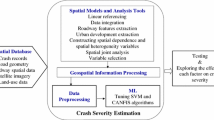Abstract
Road safety performance indicators are comprehensible tools that provide a better understanding of current safety conditions and can be used to monitor the effect of policy interventions. New insights can be gained in case one road safety index is composed of all risk indicators. The overall safety performance can then be evaluated, and countries ranked. In this paper, a promising structure of neural networks based on decision rules generated by rough sets—is proposed to develop an overall road safety index. This novel hybrid system integrates the ability of neural networks on self-learning and that of rough sets on automatically transforming data into knowledge. By means of simulation, optimal weights are assigned to seven road safety performance indicators. The ranking of 21 European countries in terms of their road safety index scores is compared to a ranking based on the number of road fatalities per million inhabitants. Evaluation results imply the feasibility of this intelligent decision support system and valuable predictive power for the road safety indicators context.


Similar content being viewed by others
References
Atiya A, Ji CY (1997) How initial conditions affect generalization performance in large networks. IEEE Trans Neural Netw 8(2):448–451
Cao G, Shiu SCK, Wang X (2003) A fuzzy-rough approach for the maintenance of distributed case-based reasoning systems. Soft Comput 7(8):491–499
European Transport Safety Council (2001) Transport Safety Performance Indicators, ETSC, Brussels
European Transport Safety Council (2008) Countdown to 2010, only two more years to act, 2nd Road Safety PIN Report ETSC, Brussels
European Commission (2001) White Paper European transport policy for 2010: time to decide, Commission of the European Communities, Brussels
Hagan MT, Menhaj MB (1994) Training feed forward network with the Marquardt algorithm. IEEE Trans Neural Netw 5(6):989–993
Haykin S (1999) Neural networks: a comprehensive foundation. Macmillan College Publishing Company, New York
Hermans E (2009) A methodology for developing a composite road safety performance index for cross-country comparison. PhD Thesis, Hasselt university, Belgium
Hermans E, Ruan D, Brijs T, Wets G, Vanhoof K (2008a) Evaluation of road safety performance indicators using OWA operators. Comput Eng Inform Sci 1:695–700
Hermans E, Van den Bossche F, Wets G (2008b) Combining road safety information in a performance index. Accid Anal Prev 40:1337–1344
Hornik K, Stinchcombe M, White H (1989) Multilayer feedforward networks are universal approximators. Neural Netw 2:359–366
Jiang Y, Zhang H, Xie J, Meng K (2006) An estimation model of research cost based on rough set and artificial neural network. LNAI 4114:766–771
Li T, Ruan D, Wets G, Song J, Xu Y (2007) A rough sets based characteristic relation approach for dynamic attribute generalization in data mining. Knowl-Based Syst 20(5):485–494
Litman T (2007) Developing indicators for comprehensive and sustainable transport planning. Transportation Research Record 2017, Transportation Research Board, 10–15
Luo J, Shao H (2006) Developing soft sensors using hybrid soft computing methodology: a neurofuzzy system based on rough set theory and genetic algorithms. Soft Comput 10(1):54–60
Midelfart H, Komorowski HJ, Nørsett K, Yadetie F, Sandvik AK, Lægreid A (2002) Learning rough set classifiers from gene expressions and clinical data. Fundamenta Informaticae 53:155–183
Nardo M, Saisana M, Saltelli A, Tarantola S, Hoffman A, Giovannini E (2005) Handbook on constructing composite indicators: methodology and user guide. OECD Statistics Working Papers, Organisation for Economic Cooperation and Development, Paris
Øhrn A, Komorowski J, Skowron A, Synak P (1998) The design and implementation of a knowledge discovery toolkit based on rough sets: the ROSETTA system. In: Polkowski L, Skowron A (eds) Rough sets in knowledge discovery. 1. Methodoloy and applications. Studies in fuzziness and soft computing, vol 18. Physica-Verlag, Heidelberg, pp 376–399
Pawlak Z (1991) Rough sets. Theoretical aspects of reasoning about data. Kluwer Academic Publishers, Boston
Pawlak Z, Polkowski L, Skowron A (2005) Rough sets. In: Rivero LC, Doorn JH, Ferragine VE (eds) Encyclopedia of database technologies and applications, Idea Group Reference, pp 575–580
Pawlak Z, Skowron A (2007) Rudiments of rough sets. Inform Sci 177(1):3–40
Peters JF, Skowron A (2002) A rough set approach to knowledge discovery. Int J Intell Syst 17(2):109–112
Reich Y, Baraib SV (2000) A methodology for building neural networks models from empirical engineering data. Eng Appl Artif Intell 13:685–694
Rumelhart DE, Hinton GE, Wiliams RJ (1986) Learning representations by back-propagating errors. Nature 323:533–536
SafetyNet Work Package 3 (2005) State-of-the-art Report on Road Safety Performance Indicators, SafetyNet
SARTRE 3 Report (2004) European Drivers and Road Risk, SARTRE
Shen Y, Hermans E, Ruan D, Wets G, Vanhoof K, Brijs T (2008) Development of a composite road safety performance index based on neural networks. In: Proceedings of 2008 international conference on intelligent systems and knowledge engineering, Xiamen, IEEE Press 2:901–906
Skowron A (1995) Extracting laws from decision tables: a rough set approach. Comput Intell 11:371–388
Swiniarski RW (2001) Rough set methods in feature reduction and classification. Int J Appl Math Comput Sci 11(3):565–582
Swiniarski RW, Skowron A (2003) Rough set methods in feature selection and recognition. Pattern Recognit Lett 24(6):833–849
Wegman F, Commandeur J, Doveh E, Eksler V, Gitelman V, Hakkert S, Lynam D, Oppe S (2008) SUNflowerNext: towards a composite road safety performance index, Deliverable D6.16 of the EU FP6 project SafetyNet
Werbos PJ (1988) Back-propagation: past and future. In: Proceeding of international conference on neural networks, San Diego, CA, 1:343–354
Witten IH, Frank E (2005) Data mining: practical machine learning tools and techniques, 2nd edn. Morgan Kaufmann, San Francisco
Xiang C, Ding SQ, Lee TH (2005) Geometrical interpretation and architecture selection of MLP. IEEE Trans Neural Netw 16(1):84–96
Xiao Z, Ye S, Zhong B, Sun C (2009) BP neural network with rough set for short term load forecasting. Expert Syst Appl 36:273–279
Author information
Authors and Affiliations
Corresponding author
Rights and permissions
About this article
Cite this article
Shen, Y., Li, T., Hermans, E. et al. A hybrid system of neural networks and rough sets for road safety performance indicators. Soft Comput 14, 1255–1263 (2010). https://doi.org/10.1007/s00500-009-0492-3
Published:
Issue Date:
DOI: https://doi.org/10.1007/s00500-009-0492-3




